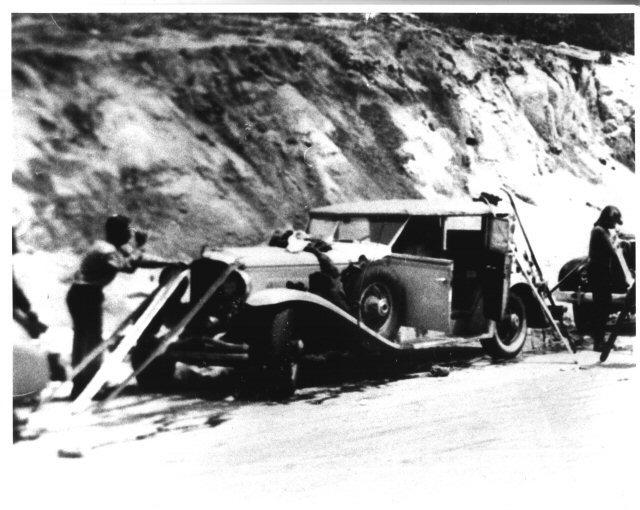In the spring of 1961 George O. Boellert (1921-2001) first drove his Model J Duesenberg from Omaha, Nebraska to Tulsa, Oklahoma, where he took first place at the First Annual Open House and Concours sponsored by the Auburn Cord Duesenberg Company of Tulsa. Later that year in Indianapolis he met Harold Ames (1894-1983), who had been the last president of Duesenberg, Inc. They talked about Arthur K. Bourne (1899-1974), from whom Boellert acquired his Duesenberg in 1959. He learned from Ames that Bourne, grandson of Frederick Bourne, president of Singer Sewing Machine Co., was one of the very first people to order a Model J. Bourne happened to be in Pebble Beach, California in 1929, the same day that Ames stopped there while enroute to Los Angeles in a Duesenberg to be shown at the Los Angeles Salon. Bourne was so impressed he ordered one on the spot, before it was shown publicly.
The chassis that was delivered to the Walter M. Murphy Company in Pasadena for the installation of the body was number 2280 (J-259). Bourne was to keep this car for thirty years, but he was kept waiting for the delivery of the car. At about this time the steering mechanism in his Stutz locked up, so he ordered a bare Model J chassis and had the Weymann leatherette body from his Stutz installed on it. This was car 2208, J-186, and the man who installed the body was Joseph Kirchhoff (1885-1964), who had worked for Walter Murphy (1881-1961) but left to start his own shop in 1926. Kirchhoff was able to modify the wheelhouse and cowl to accommodate the Weymann body and the finished car was delivered in only three weeks, so it is likely that Bourne drove the second car before receiving the first. Car 2280, J-259 was finally delivered, and became known as the "Singer Duesenberg." He drove it until 1947, then parked it indoors, put it up on blocks, and covered it. It was still in running order and had only 66,001 miles on the odometer when Boellert bought it in 1959. All it needed to run was gas and water, and he drove it from Reno back to Omaha.
Before the end of 1929, Bourne happened to see one of Kirchhoff's Packard convertible sedans, and decided to have one built for the second Duesenberg. The work was completed in 1930, again in record time. It seems likely that many, if not most, of the parts were already made, having been cast for future orders of Packards. The special features of the car, the unusually angled V-windshield and the broad polished chrome belt, were typical features of Kirchhoff's coachwork.
Car 2208 in 1934, San Marino, California. Picture provided by Joe Auch.
The original color was mushroom, with dark jade green leather seats. Kirchhoff was paid $5,000 for his work, plus the Weymann body, which he installed on his own Model A Duesenberg.

The earliest known picture of car 2208, showing the concealed door hinge, may have been taken before the car was delivered. Photo provided by Joseph Auch.
Bourne kept car 2208 for about a decade, but exactly when he parted with it is unknown, and it is uncertain who owned it next. Boellert speculates that Bourne gave it away to a soldier during World War II, but making a gift of a Duesenberg seems improbable. He also speculates, incorrectly, that it might even have been Lassiter (Red) Hoyle, who did become associated with the car in the early 1950s.
In any case, the car soon ended up at Frank Miller's Ford dealership in Pasadena. Then, in approximate chronological order, car 2208 was owned by:
Stewart M. Fraser (d. c1947), of Ryan Aircraft, San Diego, who ran it on Butane. It is believed that the picture of the car taken during a ski trip was taken in 1945 when Fraser was the owner.

Picture was taken near Big Bear in 1945.
Lee Penn Blind of Los Angeles acquired the car in November 1946. About this time the car was painted black.
Kenneth H. Deringer of Venice acquired it from Blind October 15th, 1948. The car was still being used on a daily basis.
Charles Benjamin McKesson (c1925-2007), attorney & judge in San Diego, bought the car for $350. In a letter dated 3/4/1986 to Strother MacMinn, McKesson accurately describes the car, mentions Kirchhoff as being the coachbuilder, and admits that the engine threw a rod while he had it. He claimed he "sort of" repaired it, then sold it for $450. He incorrectly remembers the engine as J-389 (an engine not associated with a frame) and Arthur Bourne as John Bourne. The letter, unfortunately, doesn't mention any dates.
Picture by Lassiter (Red) Hoyle was taken in 1951, a short time before the final mechanical breakdown.
John Morris was perhaps the last person to drive the car, but nothing is known about him or when he acquired it. We do know that he sold the car to junk dealer C. R. Zoll, of M. Z. Transmissions, located near the north end of Avalon Blvd in Los Angeles, California, after it threw a rod a second time. The picture of this car by Lassiter (Red) Hoyle was taken in 1951, a short time before it's final mechanical breakdown.